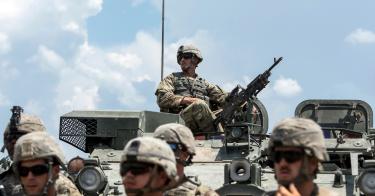Critics of defense spending (and here and here and here) often compare current spending levels with previous budgets, adjusted for inflation, to argue that today’s amounts are irresponsibly high. They then argue that other federal programs should get more funding—at the expense of defense, of course—because Americans would be better served by domestic programs that help individuals. These arguments are tragically misinformed, at best.
Comparing a dollar spent on the Vietnam-era military with a dollar spent on today’s military fails to account for the extraordinary changes in military affairs over the intervening half-century—not only in technology, but also in the cost of talent and expectations for how we treat those in uniform.
With the exception of the venerable M2 Browning .50-caliber heavy machine gun, introduced in 1933, every piece of weaponry, equipment, and platforms has become more complex, more lethal, and more capable. It is naive to think that one can blindly compare past and present defense investments simply by accounting for inflation and completely ignoring the impact that technologies have had on the conduct of military affairs.
At its most fundamental, war is a competition, with each side fielding capabilities that give it a temporary advantage. Just because you decide to stop at a particular level of capability or capacity doesn’t mean your competitor will stop at that same level. In fact, they are incentivized to continue so as to assure dominance. It’s the nature of human competition.
According to the Bureau of Labor and Statistics, inflation has raised the value of a 1970 dollar to $6.64. How does this apply to the world of military competition? Not very well at all. Some examples:
Personnel: Let’s start with the basic enlisted man or woman and a freshly minted officer. In 1970, the monthly basic pay of an E-1 private was $133.20 per month ($879 in 2020 dollars). A new second lieutenant earned $417.60 (or $2,756 adjusted). Today, their counterparts make $1,681 and $3,287—double the rate of inflation for the enlisted and 15 percent more for the officer. And this doesn’t include the additional costs of better living quarters, education benefits, healthcare, retirement benefits, nutritional advances in dining facilities, and improved training. At least part of this relates to the transition to the All Volunteer Force, a fundamental change that requires the military to compete for talent in the marketplace.
Aircraft: A new production model F-4 Phantom II fighter cost $3.5 million in 1972, $23.1 million at today’s rate. Today, a production model F-35A costs $78 million, more than three times the rate of inflation. This is not an outlier. A new F/A-18E is $75 million fully equipped for war—still three times the price of an F-4, but less able to survive in modern air combat than the F-35.
Ships: A Spruance-class destroyer cost $92 million in 1970 ($610 million adjusted for inflation) while its counterpart in 2020, an Arleigh Burke, runs $1.9 billion, again more than triple the rate of inflation.
Armor: America’s main battle tank in the 1970s was the M60A1Patton, acquired for a cool $298,000 in 1974, or $2 million in 2020 dollars. Today, we are equipping our Army with the M1A2C Abrams. It carries an active protection system to defeat modern anti-armor weapons, dramatically improved armor, and a digital and communications suite up to the challenge of modern computers, sensors, data sharing, and employment of programmable ammunition. All this comes at a cost of $9.6 million—nearly five times the rate of inflation.
Equipping the average soldier: In World War II, the Army spent $170 to equip a soldier, (the figures here are in 2006 dollars). By the 1970s, the cost had risen to $1,100. In 2007, the figure had increased to $17,500 (16 times the cost, even when adjusted for inflation), and the Army estimated that it would more than double, perhaps quadruple, over the next decade. Survival and success comes from not only being smart, well-trained, and physically fit but also having better body armor, a better weapon, improved optics and sensors, and a dramatically better ability to share information. Winning in combat at amazingly lower levels of casualties comes with a price tag. The mortality rate during World War II was 2.5 percent and in Vietnam, 0.67 percent. By 2006, rates had dropped to 0.25 percent, due in part to advances in medical care but also to the equipment, communications, training, and modern transport that accompanies our soldiers to the field.
In 1970, the defense budget was $78.5 billion; adjusting for inflation, this equates to $521 billion today. The 2020 Defense budget is $713 billion, 27 percent higher than that of 1970. While the overall budget has indeed grown in real terms, the important question is whether it has kept pace with the price of the people and hardware essential to success in war. The cost of manpower has increased by 200 percent. Our sample of combat aircraft shows an increase of 300 percent while the Navy’s primary surface combatant has more than tripled in cost. The cost of armor has grown 500 percent while the price to ensure the basic infantryman is able to succeed in battle has skyrocketed 1,600 percent. It is hard to see how a 27 percent increase in overall funding adequately supports the measures needed to prevail in combat over an enemy that is also leveraging the advances of modern technology.
In addition to all of the above, today’s military must also account for things that didn’t exist in previous eras: robotics and unmanned systems, directed energy, cyber, hypervelocity projectiles and weapons, artificial intelligence, instantaneous high-bandwidth and data-rich global telecommunications, space-based assets, extraordinarily capable sensors and guidance systems, and sophisticated warhead designs.
Vietnam-era items would not survive against their modern counterparts. It would be irresponsible—indeed, immoral—to demand that our men and women go to war today equipped, trained, and supported as if this were 1970.
Proponents of slashing defense spending on the premise that what we spend today should be bounded by what we spent in a bygone era betray the obligation we have to ensure those we send into harm’s way are ready for the task in the modern era against opponents as well-equipped as our forces.
Let’s not presume that defense of the country can be had on the cheap or that our military can do the job we ask of them with vintage equipment, funding, and support. It is true that some of those calling for cuts to military spending are also calling for the military to do less. But this also presumes the world—our major competitors in particular—will accommodate such a decision by not pressing a newfound advantage over a weaker America. If critics really want to see a smaller and less capable U.S. military, they at least need to be honest about the consequences.
This piece originally appeared in Defense One




